Geochemistry and Zircon U–Pb Geochronology of the Wugongshan Granites in the Northwestern Jiangxi Area, China: Implications for the Paleozoic Tectonic Development of South China
Abstract
:1. Introduction
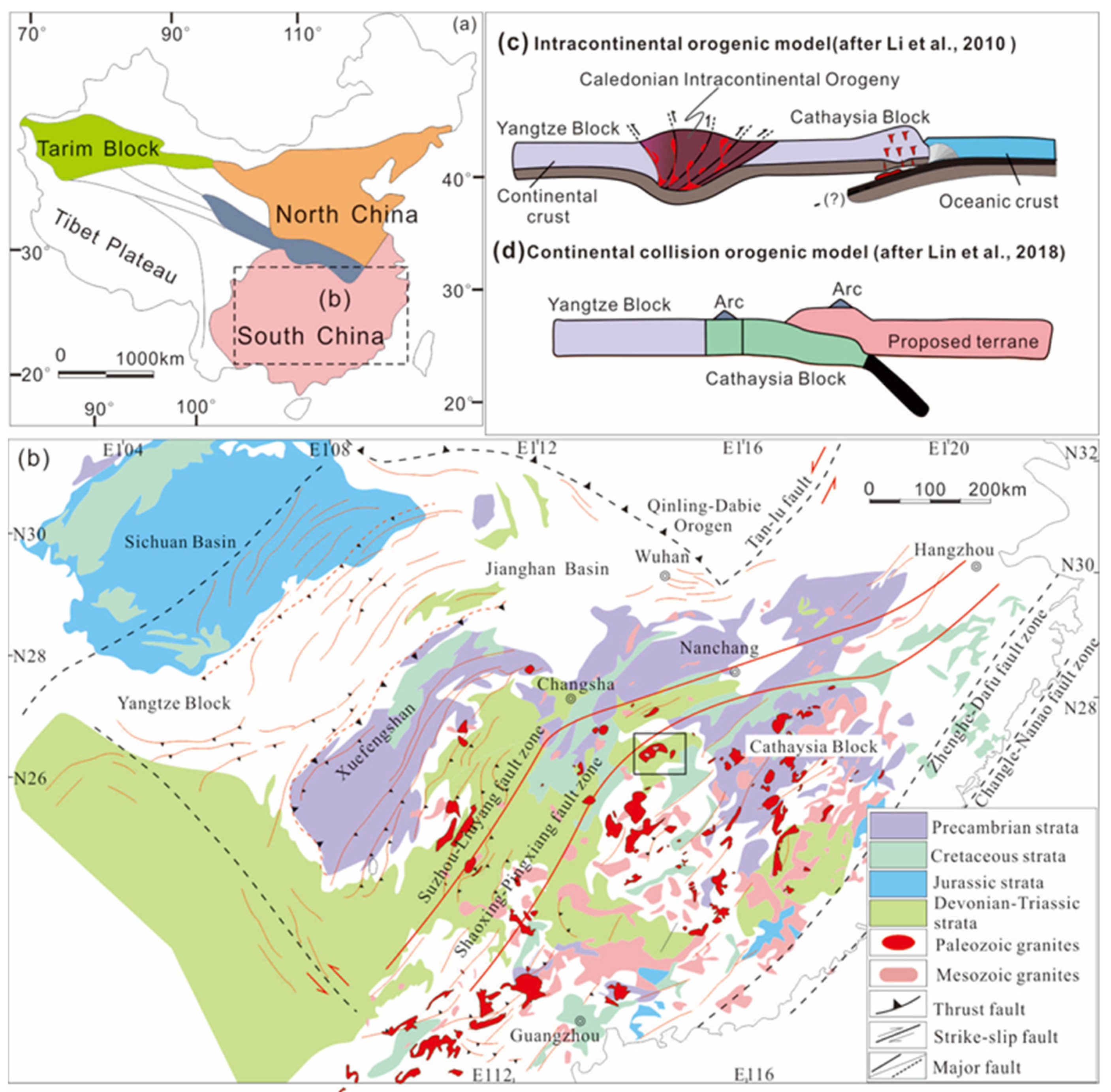
2. Geological Setting
3. Analytical Methods
3.1. LA-ICP-MS U–Pb and Hf Zircon Isotopic Analyses
3.2. Major- and Trace-Element Analyses
4. Results
4.1. Petrography
4.2. Geochronology and Hf Isotopic Compositions
4.3. Geochemistry
5. Discussion
5.1. Ages
5.2. Nature of Sources
5.3. Tectonic Implications
6. Conclusions
- (1)
- The U–Pb ages of the granites indicated that the Wugongshan granites were emplaced in 442–438 Ma.
- (2)
- Their strongly peraluminous nature, combined with the presence of muscovite, indicates that Wugongshan granites are S–type granites. The Hf isotopic compositions and the geochemical characteristics of the Wugongshan granites indicate that the magmas were derived from partial melting of the upper crust of the SCC.
- (3)
- The Caledonian granites in the Wugongshan area are being generated in an intracontinental orogenic setting, which is a far–field effects response to the convergence of the Paleo-Tethys Ocean.
Supplementary Materials
Author Contributions
Funding
Data Availability Statement
Acknowledgments
Conflicts of Interest
References
- Charvet, J.; Shu, L.S.; Shi, Y.S.; Guo, L.Z.; Faure, M. The building of south China: Collision of Yangtze and Cathaysia blocks, problems and tentative answers. J. Southeast Asian Earth Sci. 1996, 13, 223–235. [Google Scholar] [CrossRef]
- Charvet, J.; Shu, L.S.; Faure, M.; Choulet, F.; Wang, B.; Lu, H.F.; Breton, N.L. Structural development of the lower Paleozoic belt of South China: Genesis of an intracontinental orogen. J. Asian Earth Sci. 2010, 39, 309–330. [Google Scholar] [CrossRef]
- Faure, M.; Sun, Y.; Shu, L.Y.; Monie, P.; Charvet, J. Extensional tectonics within a subduction–type orogen. The case study of the Wugongshan dome (Jiangxi Province, southeastern China). Tectonophysics 1996, 263, 77–106. [Google Scholar] [CrossRef]
- Faure, M.; Der, A.W.; Walt, V.A. Globalization and Private Law: The Way Forward; Edward Elgar: Cheltenham, UK, 2010. [Google Scholar]
- Hsü, K.J.; Li, J.; Chen, H.; Wang, Q.; Sun, S.; Şengör, A.M.C. Tectonics of South China: Key to understanding West Pacific geology. Tectonophysics 1990, 183, 9–39. [Google Scholar] [CrossRef]
- Li, Z.X. Tectonic history of the major East Asian lithospheric blocks since the mid–Proterozoic–A synthesis. In Mantle Dynamics and Plate Interactions in East Asia; Geodynamics Series; American Geophysical Union: Washington, DC, USA, 1998; Volume 27, pp. 221–243. [Google Scholar]
- Li, W.X.; Li, X.H.; Li, Z.X.; Lou, F.S. Obduction–type granites within the NE Jiangxi Ophiolite: Implications for the final amalgamation between the Yangtze and Cathaysia Blocks. Gondwana Res. 2008, 13, 288–301. [Google Scholar] [CrossRef]
- Li, X.H.; Li, W.X.; Li, Z.X.; Liu, Y. 850–790 Ma bimodal volcanic and intrusive rocks in northern Zhejiang, South China: A major episode of continental rift magmatism during the breakup of Rodinia. Lithos 2008, 102, 341–357. [Google Scholar] [CrossRef]
- Li, X.H.; Li, W.X.; Li, Z.X.; Lo, C.H.; Wang, J.; Ye, M.F.; Yang, Y.H. Amalgamation between the Yangtze and Cathaysia Blocks in South China: Constraints from SHRIMP U–Pb zircon ages, geochemistry and Nd–Hf isotopes of the Shuangxiwu volcanic rocks. Precambrian Res. 2009, 174, 117–128. [Google Scholar] [CrossRef]
- Lin, S.F.; Xing, G.F.; Davis, D.W.; Yin, C.Q.; Wu, M.L.; Li, L.M.; Jiang, Y.; Chen, Z.H. Appalachian-style multi-terrane Wilson cycle model for the assembly of South China. Geology 2018, 46, 319–322. [Google Scholar] [CrossRef]
- Wang, X.L.; Zhou, J.C.; Qiu, J.S.; Gao, J.F. Geochemistry of the Meso- to Neoproterozoic basic–acid rocks from Hunan Province, South China: Implications for the evolution of the western Jiangnan orogen. Precambrian Res. 2004, 135, 79–103. [Google Scholar] [CrossRef]
- Wang, X.L.; Zhou, J.C.; Griffin, W.L.; Wang, R.C.; Qiu, J.S.; Reilly, S.Y.; Xu, X.; Liu, X.M.; Zhang, G.L. Detrital zircon geochronology of Precambrian basement sequences in the Jiangnan orogen: Dating the assembly of the Yangtze and Cathaysia Blocks. Precambrian Res. 2007, 159, 117–131. [Google Scholar] [CrossRef]
- Li, Z.X.; Li, X.H. Formation of the 1300–km–wide intracontinental orogen and postorogenic magmatic province in Mesozoic South China: A flat–slab subduction model. Geology 2007, 35, 179–182. [Google Scholar] [CrossRef]
- Li, Z.X.; Li, X.H.; Wartho, J.A.; Clark, C.; Li, W.X.; Zhang, C.L.; Bao, C.M. Magmatic and metamorphic events during the Early Paleozoic Wuyi Yunkai orogeny, southeastern South China: New age constraints and pressure–temperature conditions. Geol. Soc. Am. Bull. 2010, 122, 772–793. [Google Scholar] [CrossRef]
- Li, S.Z.; Santosh, M.; Zhao, G.C.; Zhang, G.W.; Jin, C. Intracontinental deformation in a frontier of super–convergence: A perspective on the tectonic milieu of the South China Block. J. Asian Earth Sci. 2012, 49, 313–329. [Google Scholar] [CrossRef]
- Wang, Y.J.; Fan, W.M.; Zhao, G.C.; Ji, S.C.; Peng, T.P. Zircon U–Pb geochronology of gneissic rocks in the Yunkai massif and its implications on the Caledomian event in the South China block. Gondwanan Res. 2007, 12, 404–416. [Google Scholar] [CrossRef]
- Wang, Y.J.; Zhang, F.F.; Fan, W.M.; Zhang, G.W.; Chen, S.Y.; Cawood, P.A.; Zhang, A.M. Tectonic setting of the South China Block in the Early Paleozoic: Resolving intracontinental and ocean closure models from detrital zircon U–Pb geochronology. Tectonics 2010, 29, 6020–6035. [Google Scholar] [CrossRef]
- Li, J.L. Tectonic framework and evolution of southeastern China. J. Southeast Asian Earth Sci. 1993, 8, 219–223. [Google Scholar]
- Wang, Y.; Zhang, A.; Fan, W.; Zhao, G.; Zhang, G.; Zhang, Y.; Zhang, F.; Li, S. Kwangsian crustal anatexis within the eastern South China Block: Geochemical, Zircon U–Pb geochronological and Hf isotopic fingerprints from the gneissoid granites of Wugong and Wuyi–Yunkai Domains. Lithos 2011, 127, 239–260. [Google Scholar] [CrossRef]
- Wang, D.; Zheng, J.P.; Ma, Q.; Griffin, W.L.; Zhao, H.; Wong, J. Early Paleozoic crustal anatexis in the intraplate Wuyi–Yunkai orogen, South China. Lithos 2013, 175–176, 124–145. [Google Scholar] [CrossRef]
- Zhang, G.W.; Guo, A.L.; Wang, Y.J.; Li, S.Z.; Dong, Y.P.; Liu, S.F.; He, D.F.; Cheng, S.Y.; Lu, R.K.; Yao, A.P. Tectonics of South China continent and its implications. Sci. China Earth Sci. 2013, 56, 1804–1828, (In Chinese with English Abstract). [Google Scholar] [CrossRef]
- Zhao, G.C.; Guo, J.H. Precambrian geology of China: Preface. Precambrian Res. 2012, 222–223, 1–12. [Google Scholar] [CrossRef]
- Yao, W.H.; Li, Z.X.; Li, W.X.; Wang, X.C.; Li, X.H.; Yang, J.H. Post–kinematic lithospheric delamination of the Wuyi–Yunkai orogen in South China: Evidence from ca. 435Ma high–Mg basalts. Lithos 2012, 154, 115–129. [Google Scholar] [CrossRef]
- Zhang, Y.Y.; Liu, K.; He, Q.C.; Tong, Y.; Deng, Y.F.; Yu, C.H.; Sun, J.L.; Yu, T.X.; Guo, J.H.; Wang, S.X. Petrological, zircon U–Pb, Lu–Hf isotopic geochemical characteristics of the Early Paleozoic granites in Wugong Mountain area, Jiangxi Province, and their geological significance. Geol. Rev. 2022, 69, 1004–1020, (In Chinese with English Abstract). [Google Scholar]
- Peng, S.B.; Liu, S.F.; Lin, M.S.; Wu, C.F.; Han, Q.S. Early Paleozoic Subduction in Cathaysia (Ⅰ): New Evidence from Nuodong Ophiolite. Earth Sci. 2016, 41, 765–778, (In Chinese with English Abstract). [Google Scholar]
- Peng, S.B.; Liu, S.F.; Lin, M.S.; Wu, C.F.; Han, Q.S. Early Paleozoic Subduction in Cathaysia (Ⅱ): New Evidence from the Dashuang High Magnesian–Magnesian Andesite. Earth Sci. 2016, 41, 931–947, (In Chinese with English Abstract). [Google Scholar]
- Shu, L.S.; Song, M.J.; Yao, Y.L. Appalachian-style multi-te22rrane Wilson cycle model for the assembly of South China: COMMENT. Geology 2018, 46, e445. [Google Scholar] [CrossRef]
- Shu, L.S.; Yao, J.L.; Wang, B.; Faure, M.; Charvet, C.; Chen, Y. Neoproterozoic plate tectonic process and Phanerozoic geodynamic evolution of the South China Block. Earth–Sci. Rev. 2021, 216, 103596. [Google Scholar] [CrossRef]
- Faure, M.; Charvet, J.; Chen, Y. Appalachian-style multi-terrane Wilson cycle model for the assembly of South China: COMMENT. Geology 2018, 46, e446. [Google Scholar] [CrossRef]
- Guo, L.Z.; Shi, Y.S.; Lu, H.F.; Ma, R.S.; Dong, H.G.; Yang, S.F. The Pre–devonian tectonic patterns and evolution of South China. J. Asian Earth Sci. 1989, 3, 87–93. [Google Scholar]
- Li, J.H.; Dong, S.W.; Cawood, P.A.; Zhao, G.C.; Johnston, S.T.; Zhang, Y.Q.; Xin, Y.J. An Andean–type retro–arc foreland system beneath northwest South China revealed by SINOPROBE profiling. Earth Planet. Sci. Lett. 2018, 490, 170–179. [Google Scholar] [CrossRef]
- Faure, M.; Shu, L.S.; Wang, B.; Charvet, J.; Choulet, F.; Monie, P. Intracontinental subduction: A possible mechanism for the Early Palaeozoic Orogen of SE China. Terra Nova 2009, 21, 360–368. [Google Scholar] [CrossRef]
- Zhang, F.R. The character and emplacement mechanism of gneiss in Wugong Mountain. J. East China Geol. Inst. 2000, 23, 146–149, (In Chinese with English Abstract). [Google Scholar]
- Lou, F.; Shen, W.; Wang, D.; Shu, L.; Wu, F.; Zhang, F.; Yu, J. Ziron U–Pb isotopic chronology of the Wugongshan dome compound granite in Jiangxi Province. Acta Geol. Sin. 2005, 79, 636–644. [Google Scholar]
- Sun, Y.; Shu, L.; Faure, M.; Charvet, J. Tectonic development of the metamorphic core complex of the Wugongshan in the northern Jiangxi Province. J. Nanjing Univ. (Nat. Sci.) 1997, 33, 447–449, (In Chinese with English Abstract). [Google Scholar]
- Yu, Y.; Huang, X.L.; He, P.L.; Li, J. I–type granitoids associated with the Early Paleozoic intracontinental orogenic collapse along pre–existing block boundary in South China. Lithos 2016, 248–252, 353–365. [Google Scholar] [CrossRef]
- Zhang, F.R.; Shu, L.S.; Wang, D.Z.; Yu, J.H.; Shen, W.Z. Discussions on the tectonic setting of Caledonian granitoids in the eastern segment of South Chin. Earth Sci. Front. 2009, 16, 248–260, (In Chinese with English Abstract). [Google Scholar]
- Zhang, F.F.; Wang, Y.J.; Fan, W.M.; Zhang, A.M.; Zhang, Y.Z. LA–ICPMS zircon U–Pb geochronology of late Early Paleozoic granites in eastern Hunan and western Jiangxi provinces, South China. Geochimica 2010, 39, 414–426, (In Chinese with English Abstract). [Google Scholar]
- Zhang, F.F.; Wang, Y.J.; Fan, W.M.; Zhang, A.M.; Zhang, Y.Z. Zircon U–Pb Geochronology and Hf isotopes of the Neoproterozoic Granites in the Central of Jiangnan Uplift. Geotecton. Metallog. 2011, 35, 73–84, (In Chinese with English Abstract). [Google Scholar]
- Zhang, F.F.; Wang, Y.J.; Zhang, A.M.; Fan, W.M.; Zhang, Y.Z.; Zi, J.W. Geochronological and geochemical constraints on the petrogenesis of Middle Paleozoic (Kwangsian) massive granites in the eastern South China Block. Lithos 2012, 150, 188–208. [Google Scholar] [CrossRef]
- Zhang, Y.Y.; Liu, K.; He, Q.C.; Hao, M.Y.; Guo, C.B.; Bai, J.J.; Yu, T.X. Zircon U–Pb ages, Hf isotopic characteristics, and geological significance of the Mesozoic granites in Wugong Mountains area, Jiangxi. Geol. Rev. 2022, 68, 1301–1319, (In Chinese with English Abstract). [Google Scholar]
- Kwon, S.; Park, Y.; Park, C.; Kim, H.S. Mass-balance analysis of bulk-rock chemical changes during mylonitization of a megacryst-bearing granitoid, Cheongsan shear zone, Korea. J. Asian Earth Sci. 2009, 35, 489–501. [Google Scholar] [CrossRef]
- Sun, S.S.; Dong, Y.P. High temperature ductile deformation, lithological and geochemical differentiation along the Shagou shear zone, Qinling Orogen, China. J. Struct. Geol. 2023, 167, 104791. [Google Scholar] [CrossRef]
- Andersen, T. Correction of common lead in U–Pb analyses that do not report 204Pb. Chem. Geol. 2002, 192, 59–79. [Google Scholar] [CrossRef]
- Goolaerts, A.; Mattielli, N.; Jong, J.D.; Weis, D.; Scoates, J.S. Hf and Lu isotopic reference values for the zircon standard 91500 by MC–ICP–MS. Chem. Geol. 2004, 206, 1–9. [Google Scholar] [CrossRef]
- Ludwig, K.R. User’s Manual for Isoplot 3.00: A Geochronological Toolkit for Microsoft Excel: Berkeley Geochronology Center; Special Publication; No. 4; Berkeley Geochronology Center: Berkeley, CA, USA, 2003. [Google Scholar]
- Hou, K.J.; Li, Y.H.; Tian, Y.R. In situ U–Pb zircon dating using laser ablation–multi ion counting–ICP–MS. Miner. Depos. 2009, 28, 481–492. [Google Scholar]
- Griffin, W.L.; Pearson, N.J.; Belousova, E.; Jackson, S.E.; van Achterbergh, E.; O’Reilly, S.Y.; Shee, S.R. The Hf isotope composition of cratonic mantle: LAM–MC–ICPMS analysis of zircon megacrysts in kimberlites. Geochim. Cosmochim. Acta 2000, 64, 133–147. [Google Scholar] [CrossRef]
- Griffin, W.L.; Wang, X.; Jackson, S.E.; Pearson, N.J.; Reilly, S.Y.; Xu, X.S.; Zhou, X.M. Zircon chemistry and magma mixing, SE China: In–situ analysis of Hf isotopes, Tonglu and Pingtan igneous complexes. Lithos 2002, 61, 237–269. [Google Scholar] [CrossRef]
- Sláma, J.; Koler, J.; Condon, D.J.; Crowley, J.L.; Gerdes, A.; Hanchar, J.M.; Horstwood, M.S.; Morris, G.A.; Nasdala, L.; Norberg, N. Plešovice zircon–A new natural reference material for U–Pb and Hf isotopic microanalysis. Chem. Geol. 2008, 249, 1–35. [Google Scholar] [CrossRef]
- Li, X.H. Geochemistry of the Longsheng Ophiolite from the southern margin of Yangtze Craton, SE China. Geochem. J. 1997, 31, 323–337. [Google Scholar] [CrossRef]
- Belousova, E.A.; Griffin, W.L.; O’Reilly, S.Y.; Fisher, N. Igneous zircon: Trace element composition as an indicator of source rock type. Contrib. Mineral. Petrol. 2002, 143, 602–622. [Google Scholar] [CrossRef]
- Rubatto, D.; Gebauer, D. Use of Cathodoluminescence for U-Pb Zircon Dating by Ion Microprobe: Some Examples from the Western Alps. In Cathodoluminescence in Geosciences; Springer: Berlin/Heidelberg, Germany, 2010. [Google Scholar] [CrossRef]
- Stacey, J.S.; Kramers, J.D. Approximation of terrestrial lead isotope evolution by a two–stage model. Earth Planet. Sci. Lett. 1975, 26, 207–221. [Google Scholar] [CrossRef]
- Peccerillo, A.; Taylor, S.R. Geochemistry of Eocene Calc Alkaline Volcanic Rocks from Kastamonu Area, Northern Turkey. Contrib. Mineral. Petrol. 1976, 58, 63–81. [Google Scholar] [CrossRef]
- Le Bas, M.J.; Le Maitre, R.W.; Streckeisen, A.; Zanettin, B. A Chemical Classification of Volcanic Rocks Based on the Total Alkali–Silica Diagram. J. Petrol. 1986, 27, 745–750. [Google Scholar] [CrossRef]
- Maniar, P.D.; Piccoli, P.M. Tectonic discrimination of granitoids. Geol. Soc. Am. Bull. 1989, 101, 635–643. [Google Scholar] [CrossRef]
- Rickwood, O.C. Boundary lines within petrologic diagrams which use oxides of major and minor elements. Lithos 1989, 22, 247–263. [Google Scholar] [CrossRef]
- Irvine, T.N.; Baragar, W.R.A. A guide to the chemical classification of the common volcanic rocks. Can. J. Earth Sci. 1971, 8, 523–548. [Google Scholar] [CrossRef]
- Sun, S.S.; McDonough, W.F. Chemical and isotopic systematics of oceanic basalts: Implications for mantle composition and processes. In Magmatism in the Ocean Basin; Geological Society Special Publication: London, UK, 1989; Volume 42, pp. 313–345. [Google Scholar]
- Boynton, W.V. Cosmochemistry of the Rare Earth Elements: Meteorite Studies. In Rare Earth Element Geochemistry; Henderson, P., Ed.; Elsevier: Amsterdam, The Netherlands, 1984; pp. 63–114. [Google Scholar]
- Barbarin, B. A review of the relationships between granitoid types, their origins and their geodynamic environments. Lithos 1999, 46, 605–626. [Google Scholar] [CrossRef]
- Deng, J.F.; Zhao, H.L.; Lai, S.C.; Luo, Z.H. Muscovite/two–mica granite and intracontinental subduction. Earth Sci. 1994, 19, 139–147, (In Chinese with English Abstract). [Google Scholar]
- Deng, J.F.; Zhao, H.L.; Mo, X.X.; Liu, H.X.; Luo, Z.H. Intracontinental subduction of the Yangtze Continent and Continent reducing–inferred from muscovite (two mica) granites. Geol. J. China Univ. 1995, 1, 50–57, (In Chinese with English Abstract). [Google Scholar]
- Middlemost, E.A.K. Magmas and Magmatic Rocks; Longman: London, UK, 1985; pp. 1–266. [Google Scholar]
- Middlemost, E.A.K. Naming materials in the magma/igneous rock system. Earth–Sci. Rev. 1994, 37, 215–224. [Google Scholar] [CrossRef]
- Streckeisen, A. To each plutonic rock its proper name. Earth–Sci. Rev. 1976, 12, 1–33. [Google Scholar] [CrossRef]
- Scaillet, B.; Holtz, F.; Pichavant, M. Experimental Constraints on the Formation of Silicic Magmas. Elements 2016, 12, 109–114. [Google Scholar] [CrossRef]
- Vervoort, J.D.; Pachelt, P.J.; Gehrels, G.E.; Nutman, A.P. Constraints on early Earth differentiation from hafnium and neodymium isotopes. Nature 1996, 379, 624–627. [Google Scholar] [CrossRef]
- Amelin, Y.; Lee, D.C.; Halliday, A.N. Early–middle Archean crustal evolution deduced from Lu–Hf and U–Pb isotopic studies of single zircon grains. Geochim. Cosmo Chim. Acta 2000, 64, 4205–4225. [Google Scholar] [CrossRef]
- Kinny, P.D.; Maas, R. Lu–Hf and Sm–Nd isotope systems in zircon. Zircon. Rev. Mineral. Geochem. 2003, 53, 327–341. [Google Scholar] [CrossRef]
- Wu, F.Y.; Li, X.H.; Zheng, Y.F.; Gao, S. Lu–Hf isotopic systematics and their applications in petrology. Acta Petrol. Sin. 2007, 23, 185–220. [Google Scholar]
- Sylvester, P.J. Post–collisional strongly peraluminous granites. Lithos 1998, 45, 29–44. [Google Scholar] [CrossRef]
- Defant, M.J.; Drummond, M.S. Derivation of some morden arc magmas by of young subducted lithosphere. Nature 1990, 347, 662–665. [Google Scholar] [CrossRef]
- Rollison, H.R. Using Geochemical Data: Evaluation, Presentation, Interpretation; Longman Group UK Ltd.: London, UK, 1993; pp. 107–135. [Google Scholar]
- Hollocher, B.J.; Robinson, P. Geochemistry of the metamorphosed Ordovican Taconian Magmatic Arc, Bronson Hill anticlinorium, western New England. Phys. Chem. Earth 2002, 27, 5–45. [Google Scholar] [CrossRef]
- Ge, X.Y.; Li, X.H.; Chen, Z.G.; Li, W.P. Geochemical characteristics and genesis of Yanshanian high Sr and low Y type intermediate–acid volcanic rocks in eastern China: Constraints on crustal thickness in eastern China. Chin. Sci. Bull. 2002, 47, 474–480, (In Chinese with English Abstract). [Google Scholar]
- Yu, J.H.; Lou, F.S.; Wang, L.J.; Shen, L.W.; Zhou, X.Y.; Zhang, C.H.; Huang, Z.Z. The geological significance of a Paleozoic mafic granulite found in the Yiyang area of northeastern Jiangxi Province. Chin. Sci. Bull. (Chin. Ver.) 2014, 59, 3508–3516, (In Chinese with English Abstract). [Google Scholar] [CrossRef]
- Zhong, Y.F.; Wang, L.X.; Zhao, J.H.; Liu, L.; Ma, C.Q.; Zheng, J.P.; Zhang, Z.; Luo, B.J. Partial melting of an ancient sub–continental lithospheric mantle in the Early Paleozoic intracontinental regime and its contribution to petrogenesis of the coeval peraluminous granites in South China. Lithos 2016, 264, 224–238. [Google Scholar] [CrossRef]
- Deng, J.F.; Feng, Y.F.; Di, Y.J.; Liu, C.; Xiao, Q.H.; Su, S.G.; Zhao, G.C.; Meng, F.; Xiong, L. The intrusive spatial temporal evolutional framework in the Southeast China. Geol. Rev. 2016, 62, 3–16, (In Chinese with English Abstract). [Google Scholar]
- Martínez, E.M.; Villaseca, C.; Orejana, D.; Pérez–Soba, C.; Belousova, E.; Andersen, T. Tracing magma sources of three different S–type peraluminous granitoid series by in situ U–Pb geochronology and Hf isotope zircon composition: The Variscan Montes de Toledo batholith (central Spain). Lithos 2014, 200–201, 273–298. [Google Scholar] [CrossRef]
- Harris, N.B.W.; Pearce, J.A.; Tindle, A.G. Geochemical characteristics of collision–zone magmatism. In Geological Society; Special Publications: London, UK, 1986; Volume 19, pp. 67–81. [Google Scholar]
- Pearce, J.A.; Harris, N.B.W.; Tindle, A.G. Trace element discrimination diagrams for the tectonic interpretation of granitic rocks. J. Petrol. 1984, 25, 956–983. [Google Scholar] [CrossRef]
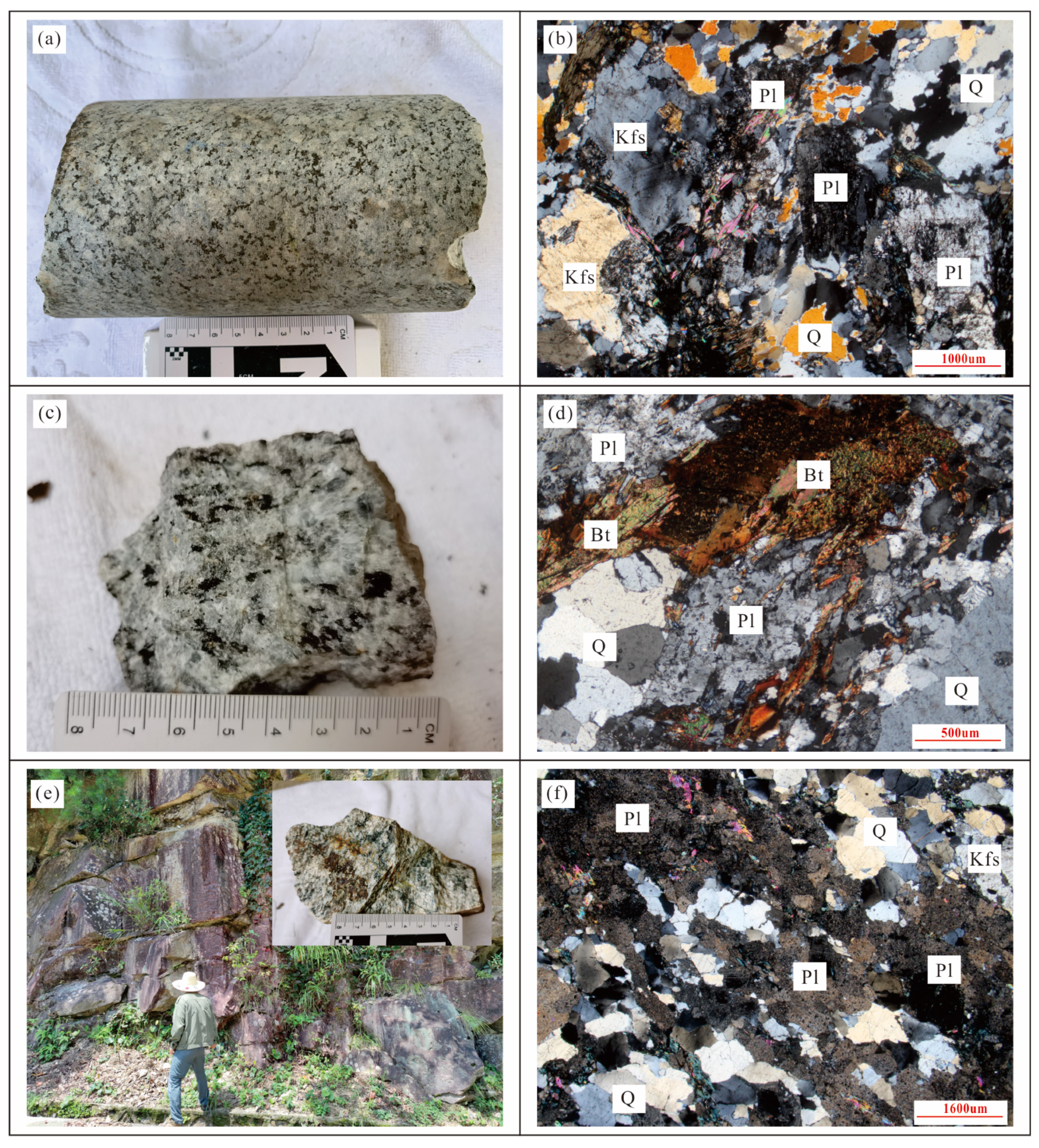
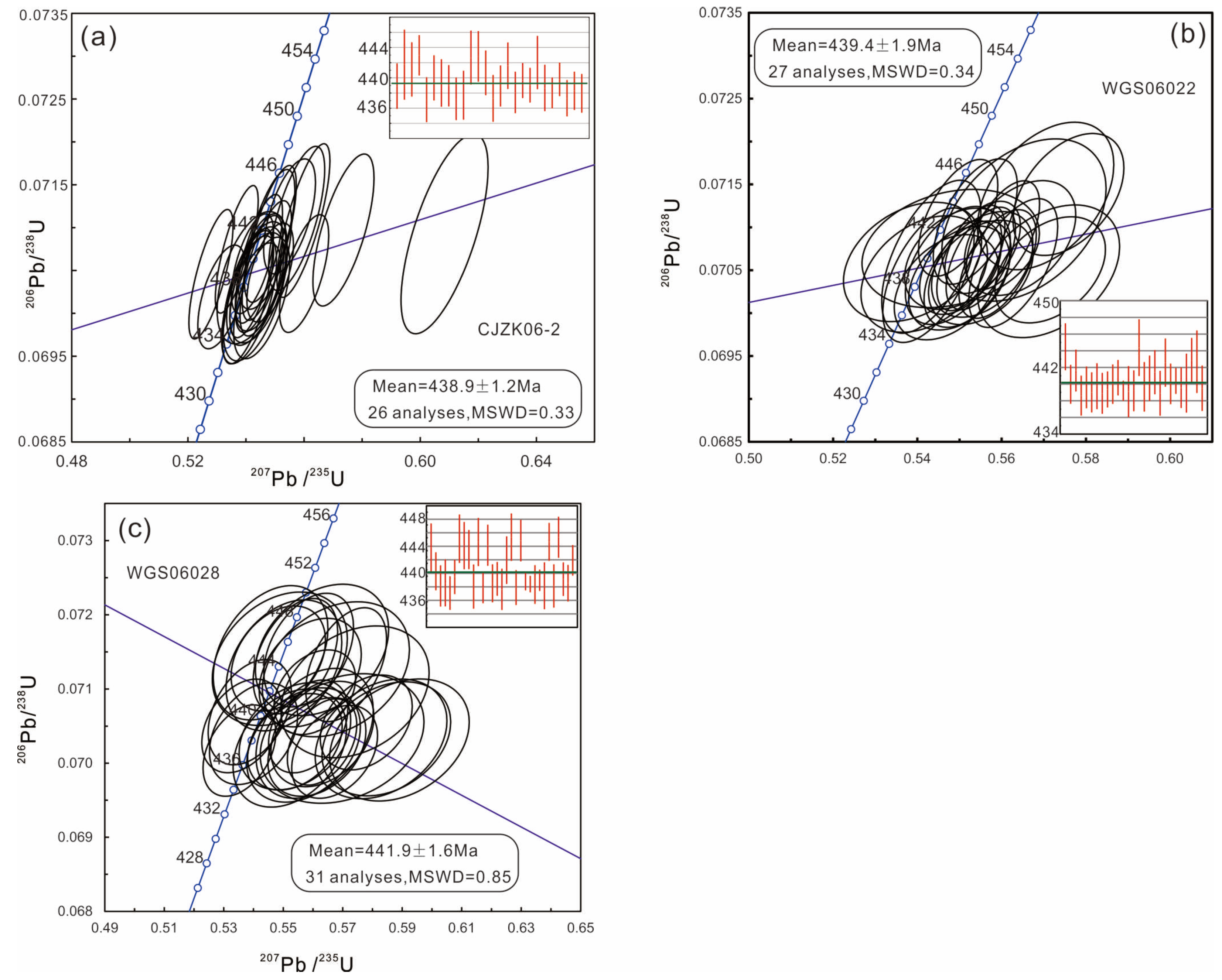
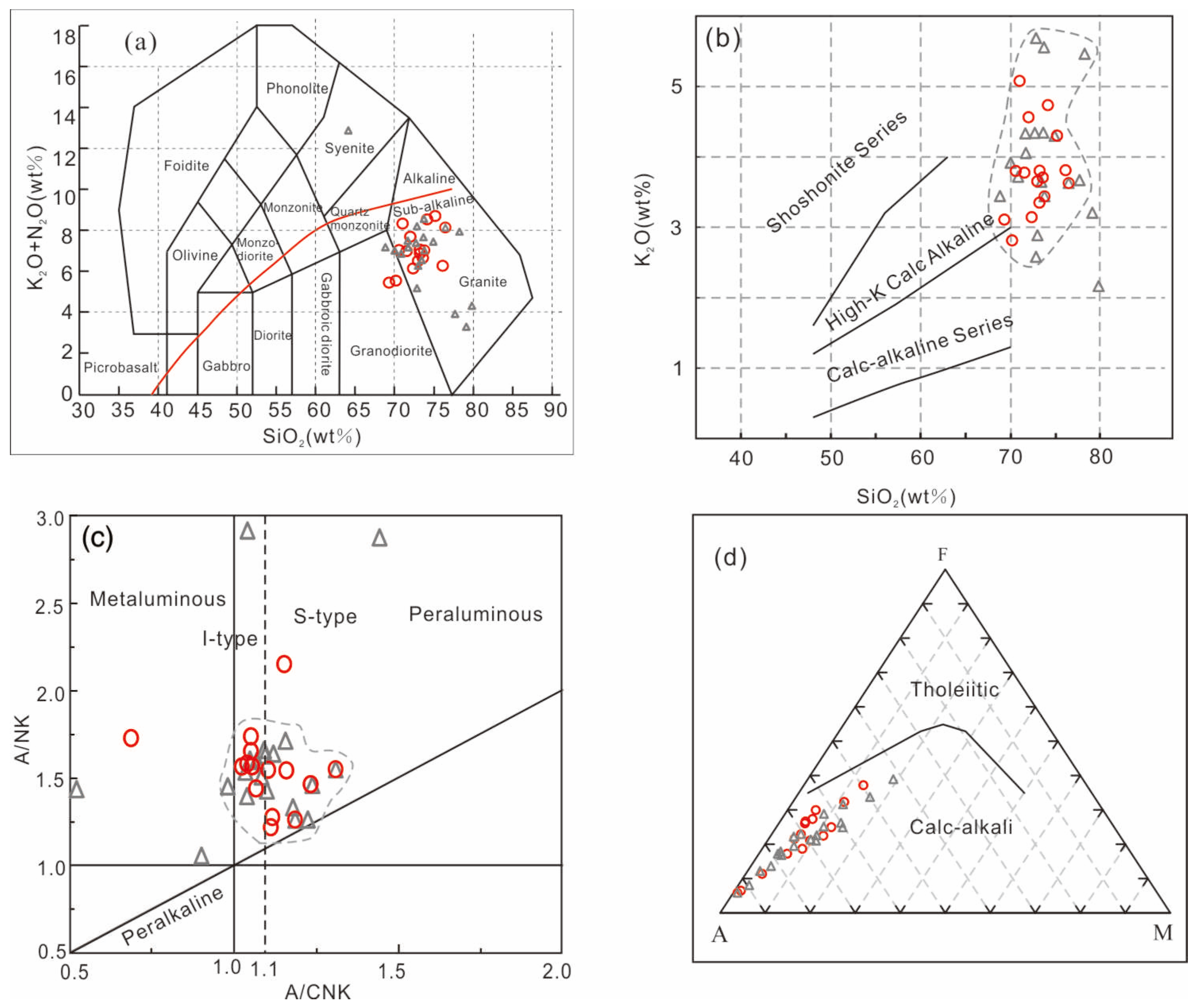
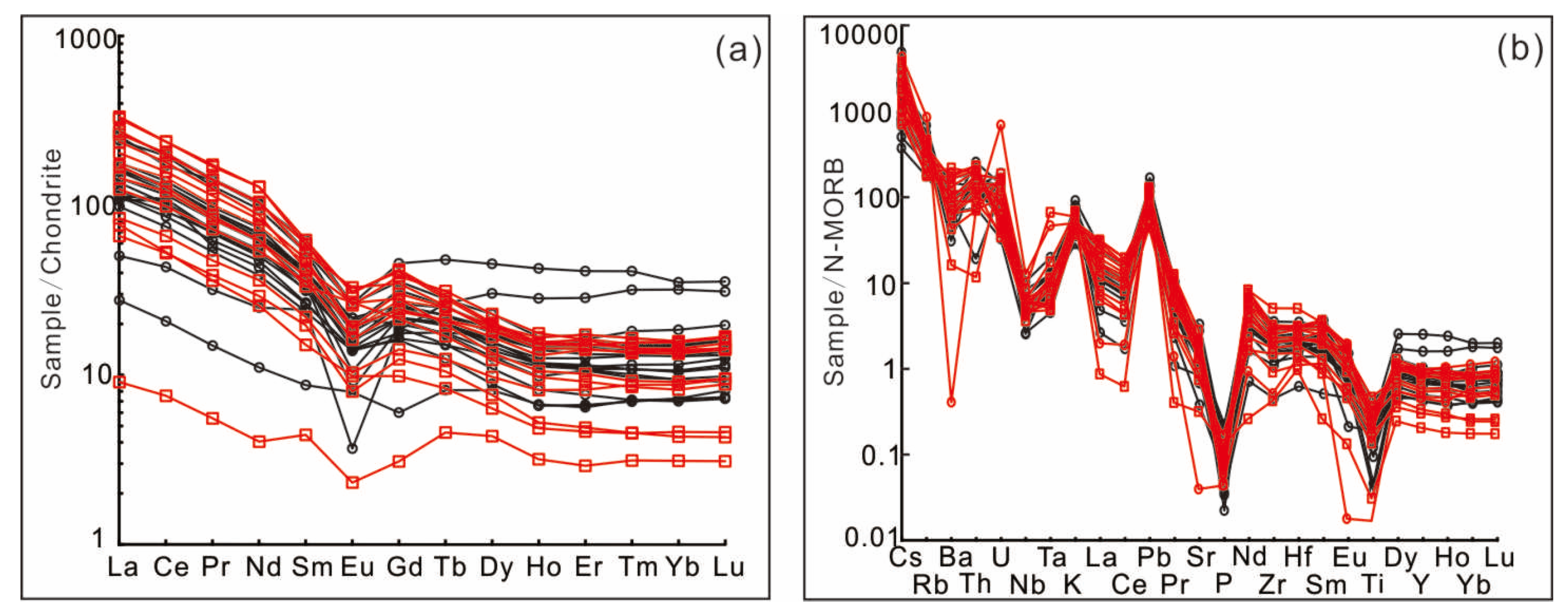



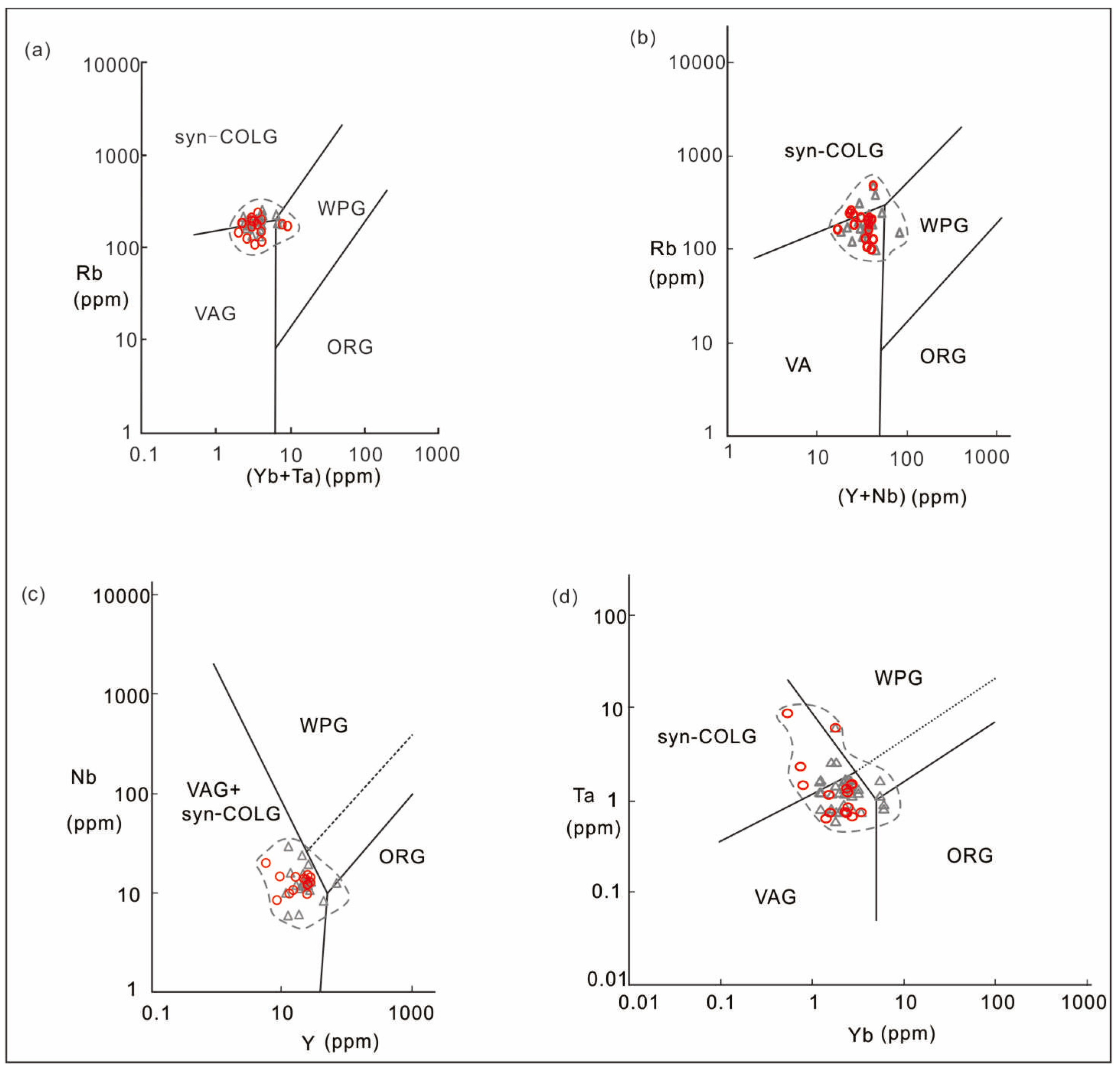
Disclaimer/Publisher’s Note: The statements, opinions and data contained in all publications are solely those of the individual author(s) and contributor(s) and not of MDPI and/or the editor(s). MDPI and/or the editor(s) disclaim responsibility for any injury to people or property resulting from any ideas, methods, instructions or products referred to in the content. |
© 2023 by the authors. Licensee MDPI, Basel, Switzerland. This article is an open access article distributed under the terms and conditions of the Creative Commons Attribution (CC BY) license (https://creativecommons.org/licenses/by/4.0/).
Share and Cite
Yang, G.; Zhang, Y.; Liu, K.; Zhou, Y.; Wang, S.; Huo, H. Geochemistry and Zircon U–Pb Geochronology of the Wugongshan Granites in the Northwestern Jiangxi Area, China: Implications for the Paleozoic Tectonic Development of South China. Minerals 2023, 13, 1427. https://doi.org/10.3390/min13111427
Yang G, Zhang Y, Liu K, Zhou Y, Wang S, Huo H. Geochemistry and Zircon U–Pb Geochronology of the Wugongshan Granites in the Northwestern Jiangxi Area, China: Implications for the Paleozoic Tectonic Development of South China. Minerals. 2023; 13(11):1427. https://doi.org/10.3390/min13111427
Chicago/Turabian StyleYang, Guangqin, Yaoyao Zhang, Kai Liu, Yi Zhou, Shuxun Wang, and Hailong Huo. 2023. "Geochemistry and Zircon U–Pb Geochronology of the Wugongshan Granites in the Northwestern Jiangxi Area, China: Implications for the Paleozoic Tectonic Development of South China" Minerals 13, no. 11: 1427. https://doi.org/10.3390/min13111427






